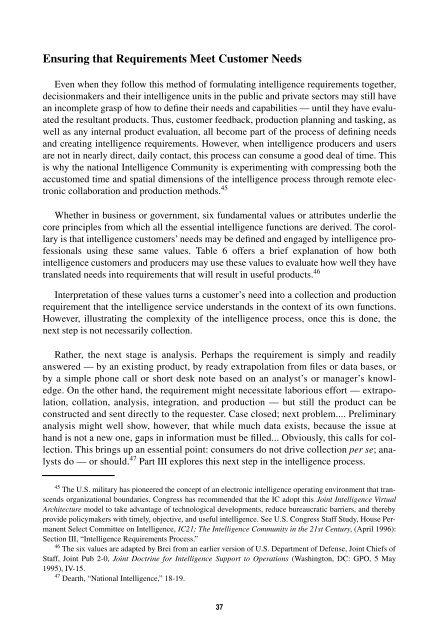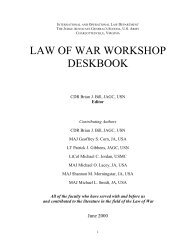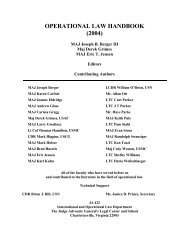learning with professionals - Higgins Counterterrorism Research ...
learning with professionals - Higgins Counterterrorism Research ...
learning with professionals - Higgins Counterterrorism Research ...
Create successful ePaper yourself
Turn your PDF publications into a flip-book with our unique Google optimized e-Paper software.
Ensuring that Requirements Meet Customer Needs<br />
Even when they follow this method of formulating intelligence requirements together,<br />
decisionmakers and their intelligence units in the public and private sectors may still have<br />
an incomplete grasp of how to define their needs and capabilities — until they have evaluated<br />
the resultant products. Thus, customer feedback, production planning and tasking, as<br />
well as any internal product evaluation, all become part of the process of defining needs<br />
and creating intelligence requirements. However, when intelligence producers and users<br />
are not in nearly direct, daily contact, this process can consume a good deal of time. This<br />
is why the national Intelligence Community is experimenting <strong>with</strong> compressing both the<br />
accustomed time and spatial dimensions of the intelligence process through remote electronic<br />
collaboration and production methods. 45<br />
Whether in business or government, six fundamental values or attributes underlie the<br />
core principles from which all the essential intelligence functions are derived. The corollary<br />
is that intelligence customers’ needs may be defined and engaged by intelligence <strong>professionals</strong><br />
using these same values. Table 6 offers a brief explanation of how both<br />
intelligence customers and producers may use these values to evaluate how well they have<br />
translated needs into requirements that will result in useful products. 46<br />
Interpretation of these values turns a customer’s need into a collection and production<br />
requirement that the intelligence service understands in the context of its own functions.<br />
However, illustrating the complexity of the intelligence process, once this is done, the<br />
next step is not necessarily collection.<br />
Rather, the next stage is analysis. Perhaps the requirement is simply and readily<br />
answered — by an existing product, by ready extrapolation from files or data bases, or<br />
by a simple phone call or short desk note based on an analyst’s or manager’s knowledge.<br />
On the other hand, the requirement might necessitate laborious effort — extrapolation,<br />
collation, analysis, integration, and production — but still the product can be<br />
constructed and sent directly to the requester. Case closed; next problem.... Preliminary<br />
analysis might well show, however, that while much data exists, because the issue at<br />
hand is not a new one, gaps in information must be filled... Obviously, this calls for collection.<br />
This brings up an essential point: consumers do not drive collection per se; analysts<br />
do — or should. 47 Part III explores this next step in the intelligence process.<br />
45 The U.S. military has pioneered the concept of an electronic intelligence operating environment that transcends<br />
organizational boundaries. Congress has recommended that the IC adopt this Joint Intelligence Virtual<br />
Architecture model to take advantage of technological developments, reduce bureaucratic barriers, and thereby<br />
provide policymakers <strong>with</strong> timely, objective, and useful intelligence. See U.S. Congress Staff Study, House Permanent<br />
Select Committee on Intelligence, IC21: The Intelligence Community in the 21st Century, (April 1996):<br />
Section III, “Intelligence Requirements Process.”<br />
46 The six values are adapted by Brei from an earlier version of U.S. Department of Defense, Joint Chiefs of<br />
Staff, Joint Pub 2-0, Joint Doctrine for Intelligence Support to Operations (Washington, DC: GPO, 5 May<br />
1995), IV-15.<br />
47 Dearth, “National Intelligence,” 18-19.<br />
37

















